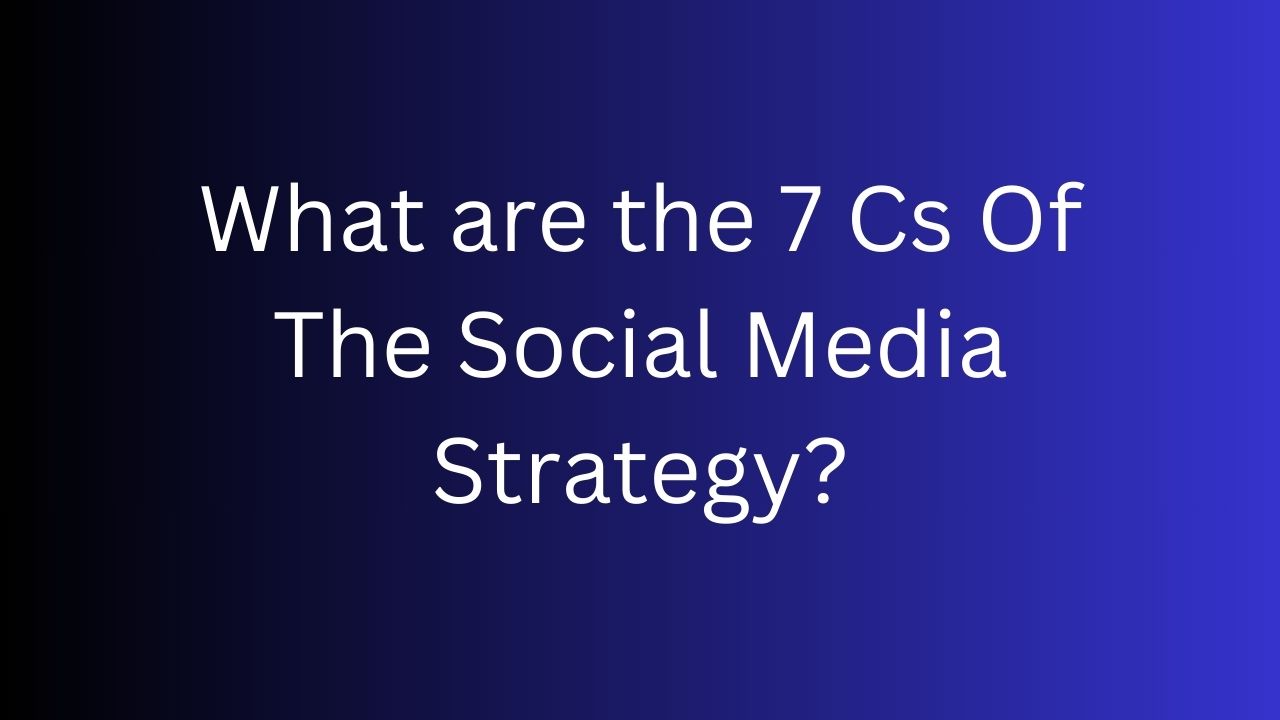The success of such a strategy is anchored in the effective execution of the 7 C’s, each playing a pivotal role in creating a dynamic and engaging online presence.
In this discussion, we will delve into the importance of content, consistency, community, conversation, channel selection, curation, and conversion, elucidating how these elements collectively form the foundation of a successful social media strategy.
What are the 7 Cs Of The Social Media Strategy?

1. Content
At the heart of any impactful social media strategy lies content. The adage “content is king” rings particularly true in social media.
Your content serves as your brand’s voice, conveying its personality, values, and offerings to your target audience. To create a lasting impact, it is imperative to produce content that is not only visually appealing but also resonates with your audience on a personal level.
This involves understanding your audience’s preferences, pain points, and aspirations.
High-quality, engaging content is the lifeblood of your social media presence. It could be visually stunning images, thought-provoking captions, or entertaining videos.
Regularly assess and refine your content strategy to stay relevant and capture the evolving interests of your audience.
2. Consistency
Consistency is the key to building trust and reliability in the eyes of your audience.
A sporadic presence on social media can lead to declining engagement and interest.
To counter this, maintain a regular posting schedule across your chosen platforms.
Whether it’s daily updates, weekly features, or monthly highlights, consistency establishes an expectation with your audience, fostering a sense of reliability.
Consistency extends beyond posting frequency; it encompasses your content’s tone, style, and timing. A cohesive and predictable presence strengthens your brand identity and encourages followers to seek out your content actively.
3. Community
Social media is not just a broadcasting platform but a community-building tool.
Fostering a sense of community among your followers involves more than just accumulating likes and follows.
Actively engage with your audience by responding to comments, acknowledging feedback, and initiating conversations.
Create a space where your followers feel heard, valued, and connected to both your brand and each other.
Encourage user-generated content, host Q&A sessions, and run polls to involve your audience in decision-making.
A strong community bolsters brand loyalty and turns your followers into brand advocates.
4. Conversation
Initiating and participating in conversations on social media transforms your brand from a mere entity to a relatable and responsive presence.
Actively listen to your audience, respond to their comments and messages, and use social media as a two-way communication channel.
Acknowledge positive feedback, address concerns promptly, and showcase the human side of your brand.
Meaningful conversations foster a deeper connection with your audience, demonstrating that your brand values their input and is responsive to their needs.
It also provides an opportunity to gather valuable insights to inform your content and strategy.
5. Channel
Choosing the right social media channels for your brand is a critical decision.
Different platforms cater to diverse demographics and content types.
Tailor your strategy to the platforms where your target audience is most active and receptive.
Instagram may be ideal for visually-driven content, while Twitter may suit real-time updates and engaging in trending conversations.
Understanding each platform’s unique features and audience demographics allows you to tailor your content for maximum impact.
This strategic approach ensures that your efforts are concentrated where they are most likely to yield results.
6. Curation
While original content is crucial, curation complements maintaining a well-rounded social media feed.
Curating content involves sharing relevant and valuable posts from other reputable sources within your industry.
This diversifies your content and positions your brand as a useful information curator.
Consider sharing industry news, expert insights, or user-generated content to give your audience a broader perspective.
Striking the right balance between original and curated content enhances the overall value you offer to your followers.
7. Conversion
Ultimately, every element of your social media strategy should contribute to your business goals. Defining and measuring key performance indicators (KPIs) is essential to track the effectiveness of your strategy.
Your social media efforts should align with broader business objectives, whether it’s increased brand awareness, website traffic, or sales conversion.
Regularly analyze your metrics to gauge the success of your campaigns.
Adjust your strategy based on the insights gained from these analytics, ensuring that your social media efforts continuously evolve to meet the changing needs of your audience and business.
A successful social media strategy hinges on seamlessly integrating the 7 C’s. Content, consistency, community, conversation, channel selection, curation, and conversion collectively create a dynamic and engaging online presence.
By understanding the nuances of each element and adapting your strategy to the ever-changing social media landscape, you can cultivate a loyal following, foster meaningful connections, and propel your brand toward its overarching goals in the digital realm.
What is a Social Media Checklist?
A social media checklist is a list of tasks that you need to complete regularly to manage your social media accounts effectively. It can help you stay organized and ensure that you are covering all of the bases.
Here is a sample social media checklist:
Daily
1. Check your notifications and respond to any comments or messages.
2. Schedule posts for the next day or week.
3. Monitor your mentions and respond to any relevant ones.
4. Engage with other users by liking, commenting, and sharing their content.
Weekly
1. Review your analytics to see how your posts are performing.
2. Adjust your social media strategy as needed.
3. Create new content and schedule it for the upcoming week.
4. Research trending topics and hashtags.
Monthly
1. Review your overall social media strategy and ensure it aligns with your business goals.
2. Conduct a social media audit to identify areas to improve.
3. Run social media contests or giveaways to engage your audience and attract new followers.
4. Collaborate with other businesses or influencers in your industry.
What is the Secret to Social Media Success?
1. Define your target audience
2. Create a social media strategy
3. Create high-quality content
4. Be consistent with your posting
5. Engage with your audience
6. Use social media analytics
What are 8 social media digital marketing strategies?
1. Content Marketing
Create and share valuable, relevant, consistent content to engage your audience. This includes blog posts, infographics, videos, and other media that resonate with your target demographic. High-quality content establishes your brand as an authority in your industry and encourages social sharing.
2. Influencer Marketing
Leverage influencers in your industry to reach a broader audience. Identify influencers whose followers align with your target demographic and collaborate with them to promote your products or services. Influencer marketing can enhance brand credibility and increase reach.
3. Social Media Advertising
Use paid social media advertising to target specific demographics and increase brand visibility. Platforms like Facebook, Instagram, Twitter, and LinkedIn offer robust advertising options that allow you to tailor your message to a highly targeted audience.
5. Engagement and Community Building
Foster a sense of community around your brand by engaging with your audience. Respond to comments, messages, and mentions promptly. Encourage user-generated content, run polls, and host Q&A sessions to create a dynamic and interactive online community.
6. Video Marketing
Capitalize on the popularity of video content across social media platforms. Create engaging and shareable videos that tell your brand story, showcase products or services, or provide valuable information. Live streaming and short-form videos are particularly effective in capturing audience attention.
7. Social Listening
Monitor and analyze social media conversations about your brand, industry, or relevant topics. Social listening tools allow you to understand customer sentiment, identify trends, and gather insights to inform your marketing strategy. Responding to customer feedback demonstrates a commitment to customer satisfaction.
8. User-Generated Content (UGC)
Encourage your audience to create and share content related to your brand. User-generated content, such as testimonials, reviews, and photos featuring your products, can be a powerful marketing tool. It builds authenticity, and trust, and serves as social proof for potential customers.
9. Data Analytics and Measurement
Implement data analytics tools to track the performance of your social media efforts. Analyze key metrics such as engagement, reach, click-through rates, and conversions. Use these insights to refine your strategy, understand what works best for your audience, and allocate resources effectively.
When implemented cohesively, these strategies can enhance your social media digital marketing efforts, increase brand awareness, and drive meaningful engagement with your target audience.
